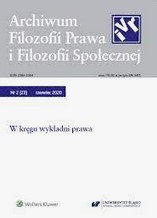Rodzaje testów judicial review a zasada proporcjonalności
Types of Judicial Review Tests and the Principle of Proportionality
Author(s): Milena Korycka-ZirkSubject(s): Constitutional Law, Human Rights and Humanitarian Law, Comparative Law
Published by: Stowarzyszenie Filozofii Prawa i Filozofii Społecznej – Sekcja Polska IVR
Keywords: judicial review (of constitutionality of statutes); principle of proportionality; strict scrutiny test; intermediate scrutiny test; rational basis test;
Summary/Abstract: Judicial review in the jurisprudence of the US Supreme Court can take the form of one of three formulas for examining an act or action of an authority (strict scrutiny test, intermediate scrutiny test, or rational basis test). In the context of the constitutional review each of these tests requires an analysis, of three essential aspects: what kind of individual interest is limited, what form of public interest legitimation is required, and how the means and the purpose so indicated are related. A detailed analysis of these standards of proportion, jurisprudentially developed and evolutionarily tightened, in confrontation with the principle of proportionality used in European constitutions (and documents on international protection of human rights) allows to formulate theses about which standard is stronger, which one creates a barrier providing better protection of individual autonomy, and which is more resistant to ‘steps backwards’ in this respect.
Journal: Archiwum Filozofii Prawa i Filozofii Społecznej
- Issue Year: 31/2022
- Issue No: 2
- Page Range: 54-69
- Page Count: 16
- Language: Polish

